Qin Li
Reconstruction of Solar EUV Irradiance Using CaII K Images and SOHO/SEM Data with Bayesian Deep Learning and Uncertainty Quantification
Aug 09, 2025Abstract:Solar extreme ultraviolet (EUV) irradiance plays a crucial role in heating the Earth's ionosphere, thermosphere, and mesosphere, affecting atmospheric dynamics over varying time scales. Although significant effort has been spent studying short-term EUV variations from solar transient events, there is little work to explore the long-term evolution of the EUV flux over multiple solar cycles. Continuous EUV flux measurements have only been available since 1995, leaving significant gaps in earlier data. In this study, we propose a Bayesian deep learning model, named SEMNet, to fill the gaps. We validate our approach by applying SEMNet to construct SOHO/SEM EUV flux measurements in the period between 1998 and 2014 using CaII K images from the Precision Solar Photometric Telescope. We then extend SEMNet through transfer learning to reconstruct solar EUV irradiance in the period between 1950 and 1960 using CaII K images from the Kodaikanal Solar Observatory. Experimental results show that SEMNet provides reliable predictions along with uncertainty bounds, demonstrating the feasibility of CaII K images as a robust proxy for long-term EUV fluxes. These findings contribute to a better understanding of solar influences on Earth's climate over extended periods.
Ultra3D: Efficient and High-Fidelity 3D Generation with Part Attention
Jul 23, 2025Abstract:Recent advances in sparse voxel representations have significantly improved the quality of 3D content generation, enabling high-resolution modeling with fine-grained geometry. However, existing frameworks suffer from severe computational inefficiencies due to the quadratic complexity of attention mechanisms in their two-stage diffusion pipelines. In this work, we propose Ultra3D, an efficient 3D generation framework that significantly accelerates sparse voxel modeling without compromising quality. Our method leverages the compact VecSet representation to efficiently generate a coarse object layout in the first stage, reducing token count and accelerating voxel coordinate prediction. To refine per-voxel latent features in the second stage, we introduce Part Attention, a geometry-aware localized attention mechanism that restricts attention computation within semantically consistent part regions. This design preserves structural continuity while avoiding unnecessary global attention, achieving up to 6.7x speed-up in latent generation. To support this mechanism, we construct a scalable part annotation pipeline that converts raw meshes into part-labeled sparse voxels. Extensive experiments demonstrate that Ultra3D supports high-resolution 3D generation at 1024 resolution and achieves state-of-the-art performance in both visual fidelity and user preference.
Correcting Noisy Multilabel Predictions: Modeling Label Noise through Latent Space Shifts
Feb 20, 2025Abstract:Noise in data appears to be inevitable in most real-world machine learning applications and would cause severe overfitting problems. Not only can data features contain noise, but labels are also prone to be noisy due to human input. In this paper, rather than noisy label learning in multiclass classifications, we instead focus on the less explored area of noisy label learning for multilabel classifications. Specifically, we investigate the post-correction of predictions generated from classifiers learned with noisy labels. The reasons are two-fold. Firstly, this approach can directly work with the trained models to save computational resources. Secondly, it could be applied on top of other noisy label correction techniques to achieve further improvements. To handle this problem, we appeal to deep generative approaches that are possible for uncertainty estimation. Our model posits that label noise arises from a stochastic shift in the latent variable, providing a more robust and beneficial means for noisy learning. We develop both unsupervised and semi-supervised learning methods for our model. The extensive empirical study presents solid evidence to that our approach is able to consistently improve the independent models and performs better than a number of existing methods across various noisy label settings. Moreover, a comprehensive empirical analysis of the proposed method is carried out to validate its robustness, including sensitivity analysis and an ablation study, among other elements.
Heterogeneity-aware Personalized Federated Learning via Adaptive Dual-Agent Reinforcement Learning
Jan 28, 2025



Abstract:Federated Learning (FL) empowers multiple clients to collaboratively train machine learning models without sharing local data, making it highly applicable in heterogeneous Internet of Things (IoT) environments. However, intrinsic heterogeneity in clients' model architectures and computing capabilities often results in model accuracy loss and the intractable straggler problem, which significantly impairs training effectiveness. To tackle these challenges, this paper proposes a novel Heterogeneity-aware Personalized Federated Learning method, named HAPFL, via multi-level Reinforcement Learning (RL) mechanisms. HAPFL optimizes the training process by incorporating three strategic components: 1) An RL-based heterogeneous model allocation mechanism. The parameter server employs a Proximal Policy Optimization (PPO)-based RL agent to adaptively allocate appropriately sized, differentiated models to clients based on their performance, effectively mitigating performance disparities. 2) An RL-based training intensity adjustment scheme. The parameter server leverages another PPO-based RL agent to dynamically fine-tune the training intensity for each client to further enhance training efficiency and reduce straggling latency. 3) A knowledge distillation-based mutual learning mechanism. Each client deploys both a heterogeneous local model and a homogeneous lightweight model named LiteModel, where these models undergo mutual learning through knowledge distillation. This uniform LiteModel plays a pivotal role in aggregating and sharing global knowledge, significantly enhancing the effectiveness of personalized local training. Experimental results across multiple benchmark datasets demonstrate that HAPFL not only achieves high accuracy but also substantially reduces the overall training time by 20.9%-40.4% and decreases straggling latency by 19.0%-48.0% compared to existing solutions.
Monotonic Learning in the PAC Framework: A New Perspective
Jan 09, 2025Abstract:Monotone learning refers to learning processes in which expected performance consistently improves as more training data is introduced. Non-monotone behavior of machine learning has been the topic of a series of recent works, with various proposals that ensure monotonicity by applying transformations or wrappers on learning algorithms. In this work, from a different perspective, we tackle the topic of monotone learning within the framework of Probably Approximately Correct (PAC) learning theory. Following the mechanism that estimates sample complexity of a PAC-learnable problem, we derive a performance lower bound for that problem, and prove the monotonicity of that bound as the sample sizes increase. By calculating the lower bound distribution, we are able to prove that given a PAC-learnable problem with a hypothesis space that is either of finite size or of finite VC dimension, any learning algorithm based on Empirical Risk Minimization (ERM) is monotone if training samples are independent and identically distributed (i.i.d.). We further carry out an experiment on two concrete machine learning problems, one of which has a finite hypothesis set, and the other of finite VC dimension, and compared the experimental data for the empirical risk distributions with the estimated theoretical bound. The results of the comparison have confirmed the monotonicity of learning for the two PAC-learnable problems.
Deep Computer Vision for Solar Physics Big Data: Opportunities and Challenges
Sep 07, 2024Abstract:With recent missions such as advanced space-based observatories like the Solar Dynamics Observatory (SDO) and Parker Solar Probe, and ground-based telescopes like the Daniel K. Inouye Solar Telescope (DKIST), the volume, velocity, and variety of data have made solar physics enter a transformative era as solar physics big data (SPBD). With the recent advancement of deep computer vision, there are new opportunities in SPBD for tackling problems that were previously unsolvable. However, there are new challenges arising due to the inherent characteristics of SPBD and deep computer vision models. This vision paper presents an overview of the different types of SPBD, explores new opportunities in applying deep computer vision to SPBD, highlights the unique challenges, and outlines several potential future research directions.
Verifiable cloud-based variational quantum algorithms
Aug 27, 2024Abstract:Variational quantum algorithms (VQAs) have shown potential for quantum advantage with noisy intermediate-scale quantum (NISQ) devices for quantum machine learning (QML). However, given the high cost and limited availability of quantum resources, delegating VQAs via cloud networks is a more practical solution for clients with limited quantum capabilities. Recently, Shingu et al.[Physical Review A, 105, 022603 (2022)] proposed a variational secure cloud quantum computing protocol, utilizing ancilla-driven quantum computation (ADQC) for cloud-based VQAs with minimal quantum resource consumption. However, their protocol lacks verifiability, which exposes it to potential malicious behaviors by the server. Additionally, channel loss requires frequent re-delegation as the size of the delegated variational circuit grows, complicating verification due to increased circuit complexity. This paper introduces a new protocol to address these challenges and enhance both verifiability and tolerance to channel loss in cloud-based VQAs.
Back-Projection Diffusion: Solving the Wideband Inverse Scattering Problem with Diffusion Models
Aug 05, 2024



Abstract:We present \textit{Wideband back-projection diffusion}, an end-to-end probabilistic framework for approximating the posterior distribution induced by the inverse scattering map from wideband scattering data. This framework leverages conditional diffusion models coupled with the underlying physics of wave-propagation and symmetries in the problem, to produce highly accurate reconstructions. The framework introduces a factorization of the score function into a physics-based latent representation inspired by the filtered back-propagation formula and a conditional score function conditioned on this latent representation. These two steps are also constrained to obey symmetries in the formulation while being amenable to compression by imposing the rank structure found in the filtered back-projection formula. As a result, empirically, our framework is able to provide sharp reconstructions effortlessly, even recovering sub-Nyquist features in the multiple-scattering regime. It has low-sample and computational complexity, its number of parameters scales sub-linearly with the target resolution, and it has stable training dynamics.
ChatSchema: A pipeline of extracting structured information with Large Multimodal Models based on schema
Jul 26, 2024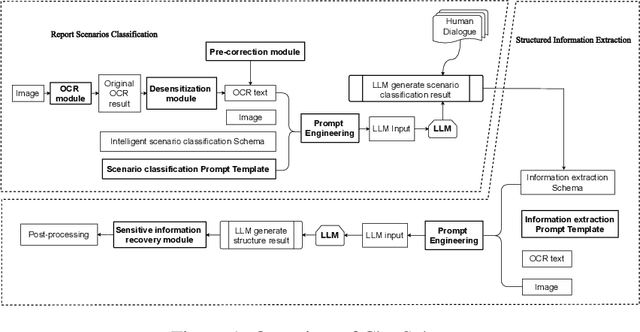

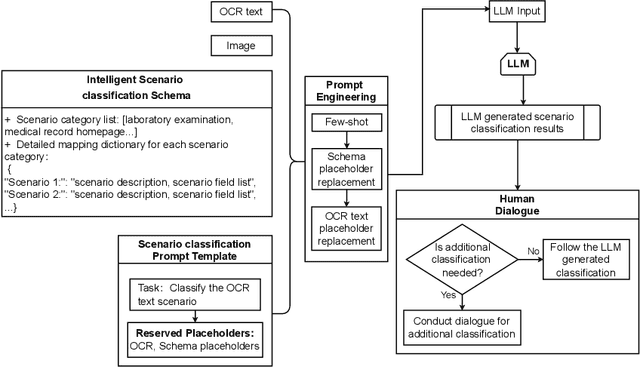

Abstract:Objective: This study introduces ChatSchema, an effective method for extracting and structuring information from unstructured data in medical paper reports using a combination of Large Multimodal Models (LMMs) and Optical Character Recognition (OCR) based on the schema. By integrating predefined schema, we intend to enable LMMs to directly extract and standardize information according to the schema specifications, facilitating further data entry. Method: Our approach involves a two-stage process, including classification and extraction for categorizing report scenarios and structuring information. We established and annotated a dataset to verify the effectiveness of ChatSchema, and evaluated key extraction using precision, recall, F1-score, and accuracy metrics. Based on key extraction, we further assessed value extraction. We conducted ablation studies on two LMMs to illustrate the improvement of structured information extraction with different input modals and methods. Result: We analyzed 100 medical reports from Peking University First Hospital and established a ground truth dataset with 2,945 key-value pairs. We evaluated ChatSchema using GPT-4o and Gemini 1.5 Pro and found a higher overall performance of GPT-4o. The results are as follows: For the result of key extraction, key-precision was 98.6%, key-recall was 98.5%, key-F1-score was 98.6%. For the result of value extraction based on correct key extraction, the overall accuracy was 97.2%, precision was 95.8%, recall was 95.8%, and F1-score was 95.8%. An ablation study demonstrated that ChatSchema achieved significantly higher overall accuracy and overall F1-score of key-value extraction, compared to the Baseline, with increases of 26.9% overall accuracy and 27.4% overall F1-score, respectively.
CMRxRecon2024: A Multi-Modality, Multi-View K-Space Dataset Boosting Universal Machine Learning for Accelerated Cardiac MRI
Jun 27, 2024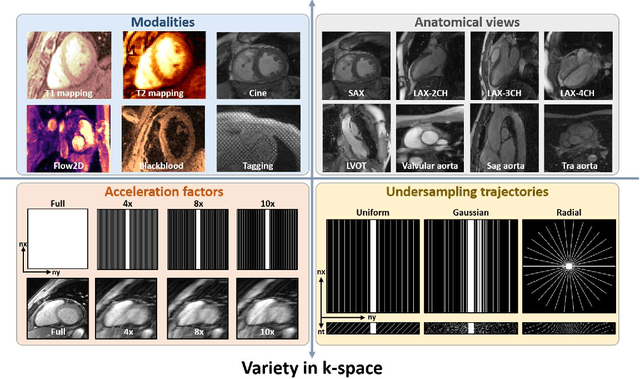
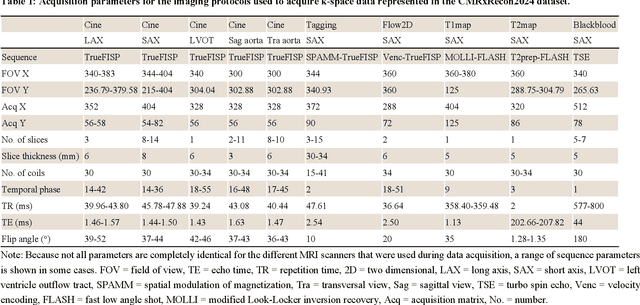
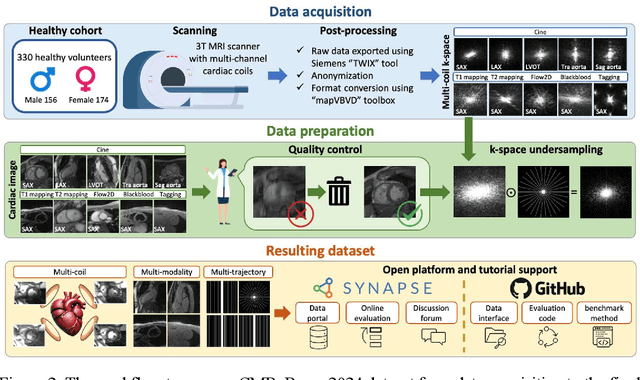
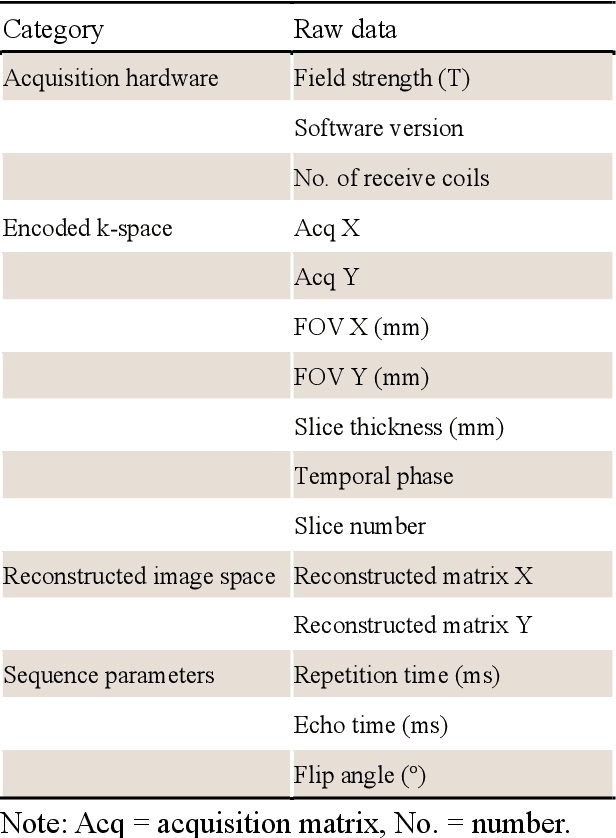
Abstract:Cardiac magnetic resonance imaging (MRI) has emerged as a clinically gold-standard technique for diagnosing cardiac diseases, thanks to its ability to provide diverse information with multiple modalities and anatomical views. Accelerated cardiac MRI is highly expected to achieve time-efficient and patient-friendly imaging, and then advanced image reconstruction approaches are required to recover high-quality, clinically interpretable images from undersampled measurements. However, the lack of publicly available cardiac MRI k-space dataset in terms of both quantity and diversity has severely hindered substantial technological progress, particularly for data-driven artificial intelligence. Here, we provide a standardized, diverse, and high-quality CMRxRecon2024 dataset to facilitate the technical development, fair evaluation, and clinical transfer of cardiac MRI reconstruction approaches, towards promoting the universal frameworks that enable fast and robust reconstructions across different cardiac MRI protocols in clinical practice. To the best of our knowledge, the CMRxRecon2024 dataset is the largest and most diverse publicly available cardiac k-space dataset. It is acquired from 330 healthy volunteers, covering commonly used modalities, anatomical views, and acquisition trajectories in clinical cardiac MRI workflows. Besides, an open platform with tutorials, benchmarks, and data processing tools is provided to facilitate data usage, advanced method development, and fair performance evaluation.
 Add to Chrome
Add to Chrome Add to Firefox
Add to Firefox Add to Edge
Add to Edge